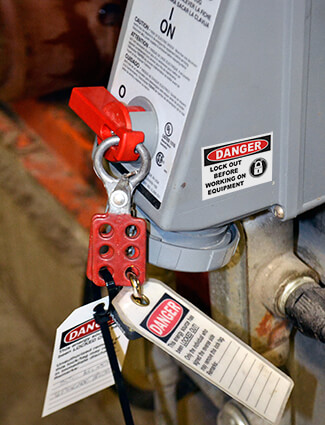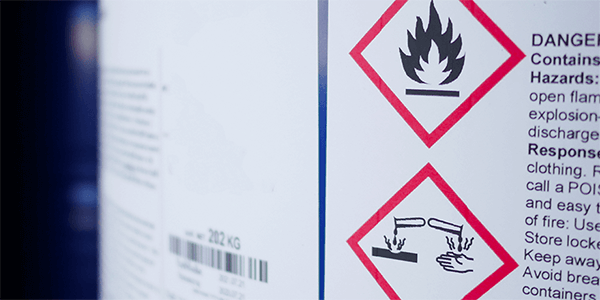Brewery Safety: Common OSHA Violations and How to Stay Safe

Beer has never been a bigger business in the United States than it is today. The Brewers Association reported that small and independent brewers produced 24.3 million barrels of beer in 2022.
But the booming sales and production numbers come at a cost: safety.
Many breweries are open to the public for tours and tastings, and they typically employ several brewers who work around hazardous chemicals, in confined spaces, and with dangerous equipment. It's important to understand what brewers are being cited for and how they can stay safe on the job.
Common OSHA Violations at Breweries
Here are some of the most common Occupational Safety and Health Administration (OSHA) citations issued to breweries and how breweries can ensure a safe, working environment for employees and visitors alike.
Confined Space Safety
Brewers occasionally spend time cleaning, servicing, or performing maintenance inside fermenters, grain silos, mash tuns, kettles, and more. OSHA inspectors have commonly cited breweries for not providing safe practices while working in these confined spaces.
29 CFR 1910.146, OSHA's regulation that governs permit-required confined spaces, defines a "confined space" as an area that meets the following three conditions:
- Is large enough and so configured that an employee can bodily enter and perform assigned work; and
- Has limited or restricted means for entry or exit; and
- Is not designed for continuous employee occupancy.
Where a confined space could pose a hazard to a worker, OSHA requires several safeguards to ensure confined space safety. Those include:
- Written Confined Space Permit Program: OSHA requires a written program that, among other things, identifies and evaluates the hazards that may be present, requires testing the atmospheric conditions of a confined space, and includes instructions for summoning rescue and emergency services.
- Entry Permits: Employees must receive a confined space entry permit, signed by the entry supervisor, before performing work in a confined space.
- Worker Training: Employers must provide all necessary training for workers who may enter a permit-required confined space.
Ergonomic Injuries
Brewers may spend much of their day transporting kegs, lifting bags of grain, and performing other labor-intensive operations.
It's no surprise that ergonomic violations are commonly cited under the OSHA General Duty Clause.
Given that OSHA does not yet have a specific standard regarding ergonomics, breweries can be cited under the clause, which mandates that employers provide a workplace "free from recognized hazards that are causing or are likely to cause death or serious physical harm."
Ergonomic injuries are a recognized hazard, which means employers are at risk when they don't attempt to mitigate the dangers associated with improper lifting tasks.
Process Safety Management Violations
Most breweries rely on ammonia refrigeration to keep beer and other supplies cold. What many don't realize is that ammonia is one of the dangerous chemicals covered under 29 CFR 1910.119, OSHA's regulation for preventing or minimizing the release of toxic, reactive, flammable, or explosive chemicals.
Breweries have received over 50 citations under the standard. The citations cover various violations, including:
- Failure to develop a process hazard analysis in accordance with the standard
- Failure to outline processes for operating and emergency use of refrigeration systems
- Failure to create written procedures and train employees to maintain relevant equipment
Lockout/Tagout Violations
 Brewers occasionally shut down fermentation tanks, mash tuns, kettles, bottling lines, and more to perform maintenance or service these machines. In doing so, they must follow specific lockout/tagout (LOTO) practices and procedures to safeguard employees from the unexpected startup of machinery and equipment.
Brewers occasionally shut down fermentation tanks, mash tuns, kettles, bottling lines, and more to perform maintenance or service these machines. In doing so, they must follow specific lockout/tagout (LOTO) practices and procedures to safeguard employees from the unexpected startup of machinery and equipment.
LOTO violations are routinely among OSHA's most common citations each year, but breweries can take a few steps to ensure safety while performing these tasks.
- Understand LOTO program requirements: 29 CFR 1910.147, OSHA's requirements for the control of hazardous energy, requires that employers create a LOTO program that protects employees from all sources of hazardous energy (including electrical energy, hydraulic pressure, gravity, and heat).
- Create written procedures: OSHA requires employers to create and employ written procedures on what will be done to control hazardous energy.
Hazard Communication Violations
Water, hops, grains, yeast, and other ingredients may all be used at various points in the brewing process, creating the need for chemical cleaning agents once the beer has been bottled, kegged, or canned.
29 CFR 1910.1200 is OSHA's regulation that governs the labeling of chemical hazards in the workplace (more commonly known as HazCom 2012). Breweries have been cited on roughly 50 occasions for various hazard communication violations, including:
- Missing or incomplete hazard communication plans
- Missing or inadequate chemical labels and Safety Data Sheets
- Lack of effective training on handling chemicals or monitoring the presence of chemicals
Personal Protective Equipment (PPE) Violations
Boiling water, toxic cleaning chemicals, and hazardous vapors are just some of the hazards brewers may face on any given day. It's important that employees wear the right equipment in these scenarios, yet breweries have been cited repeatedly for not providing proper PPE, as required in 29 CFR 1910.133(a)(1). OSHA's standard for eye and face protection maintains that employers provide the appropriate gear when employees are exposed to hazards from a variety of sources.
The PPE standard outlines the types of PPE designed to protect the eyes and face, various hazard types, and requirements for when gear must be provided.
Forklift and Powered Truck Violations
Breweries rely regularly on forklifts and powered trucks to transport raw materials, move and reach equipment, and lift heavy items (such as pallets of kegs). Yet brewers have been cited numerous times in recent years for failing to train employees to safely operate forklifts and powered trucks.
OSHA's requirements for forklifts and powered trucks can be found in 29 CFR 1910.178. The standard maintains that employees receive training and evaluation before operating a powered truck. The training should consist of the following steps:
- Trainees may only operate a forklift or powered truck under the supervision of a colleague or manager equipped with the knowledge, training, and expertise to offer training. The training must be given in a manner that does not endanger any employees.
- Training must include a mix of formal instruction (including lectures, written materials, and visual presentations), practical training (including demonstrations given by the trainer and exercises undertaken by the trainee), and an evaluation of the trainee's competence.
- Training should cover numerous topics related to safely operating powered trucks, including steering, how to use controls and instrumentation, visibility, workplace conditions, and more.
DuraLabel OSHA Safety Solutions for Breweries
In breweries, maintaining safety requires clear, effective communication. DuraLabel provides durable signs and labels designed to withstand challenging environments, ensuring that crucial safety information is visible where it's needed most. From marking hazardous areas to identifying equipment controls, DuraLabel’s solutions reinforce safety protocols and help prevent accidents.
DuraLabel Toro Max Industrial Sign and Label Print System, with its on-demand printing capabilities, allows breweries to create custom signs and labels suited for any area of the facility. Its high-quality materials and vivid print ensure labels stay legible, even in tough brewery conditions. Whether you need to mark restricted zones, label chemical storage areas, or post important reminders, Toro Max offers the flexibility and reliability breweries can trust.
For more resources on enhancing safety, DuraLabel’s team is ready to help you build a visually safe environment. Call us at 1-888-695-5670 to learn more about our comprehensive safety labeling solutions tailored for breweries.
Want to learn more about creating a compliant brewery? Download the free Facility Signage Handbook. From compliance to improving communication, this handbook provides key information to make informed decisions about your facility's signage.
Read Next:
Related Resources

What is HAZOP? HAZOP Analysis and Industrial Label Printer Insights
Workplace safety should always be at the forefront of your mind. Many recommendations exist on how to go ...
Read
What is HazCom? Your Guide to Chemical Labeling, GHS, & OSHA Standards
What Is OSHA’s Hazard Communication Standard (HazCom)? "HazCom" is short for "Hazard Communication," OSHA’s ...
Read
How DuraLabel Systems Improve GHS Labels for Compliance and Safety
How DuraLabel Printers Simplify GHS Labeling for Compliance and Safety In regulated industrial environments, ...
Read.png)





